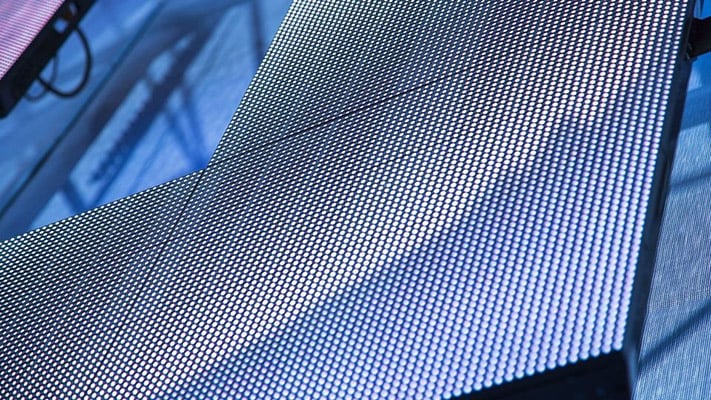Userful LED & LCD Screens for Video Walls & Digital Displays
The Leading Provider of AV as a Service (AVaaS)

A detailed comparative analysis of the leading digital screen hardware for corporate display applications.
LED and LCD Digital Displays Video Walls
LCDs and LEDs are the main hardware technologies used for video walls and digital displays. High demand and development have accelerated the market growth of display screens—with more options for buyers, at comparatively lower costs. At the same time, a rapidly changing industrial landscape obsoletes large-scale and expensive proprietary applications at a much faster pace.
A comprehensive analysis of LEDs and LCDs—especially concerning their hardware limitations and costs—would assist buyers to invest in the right solution for their video walls and display needs.
Difference between LCD and LEDs
LCD stands for Liquid Crystal Display, while LED stands for (and uses an array of) Light Emitting Diodes.
LED displays are essentially LCD technology with LED back-lighting. Realistically, the two display types are a lot more similar than they are different. Both contain liquid crystals between two layers of polarized glass. In fact, while LCDs traditionally used CCFL (cold cathode fluorescent lamps) for illumination, the vast majority now use LED backlights as well; with slight differences that separate the types.

OLEDs and Beyond
An emerging class of commercial display technologies consists of OLEDs and MicroLEDs, that can emit visible light without backlights. However, they are commercially used for small applications such as mobiles due to very high costs.
Choosing between LEDs and LCDs
Regardless of type, digital display technology is rapidly moving from expensive, use-case-specific, and proprietary screens to cheaper, multi-purpose, and standard ones. This aligns with the paradigm shift of IoT and cloud-based computing—which relegates content storage, processing, and management to AV-over-IP software—drastically scaling installation size while optimizing hardware and support costs.
Configuration
With standard HDMI ports, both technologies offer optimal connectivity to external multimedia sources, with great picture and sound qualities. While ports such as RS-232 are less common in new screen models, they could be necessary to certain organizations and are more commonly found in older LCD models.
Color, Brightness, and Display Quality
LEDs are slightly better than LCDs for color accuracy—with RGB lights for sharper and more realistic outputs. LEDs are also dimmable, which allows for sharper contrast and truer black. Color differences are more discernible from close viewing. While screen resolution (measured in pixels) is a standard measure for LCD screens, Pixel Pitch—the unit distance between the LED lights—is more important for LED panels. A dense concentration of LED lights (or small pitch), results in higher display quality.
Additionally, optimal screen brightness of over 12,000 nits (measure for luminance) for outdoor use-cases and large distance viewing is enabled with LEDs.
Hardware vs Software Features
Designated commercial displays are optimized for public and corporate use and offer greater functionality than conventional tv screens. Aside from display configuration, they are likelier to offer better heavy-duty protection against dust, changes in temperature, overheating, and physical damage.
Security
Since the most valuable part of video walls is often the content they display, preventing data theft and unauthorized access to the internal network is critically important. Proprietary hardware cannot meet or keep up with ever-changing security trends, and a software platform is the best option to mitigate vulnerabilities and protect servers from unauthorized access.
Best Practices
While switching cables to change content, using on/off switches to conserve energy or operating screens with remote controls is practical for personal use, corporate displays require centralized management. Hardware features cannot efficiently automate, schedule, or control content output—especially for mission-critical, large-scale, or high-performance display applications. Such use-cases require software display management tools.
Power Consumption
While power usage is roughly proportional to screen size, LED screens to offer greater energy efficiency per pixel than LCDs. This is largely due to LED displays utilizing newer technology, and their ability to dim backlights (such as for absolute black). For large-scale and prolonged use installations—these differences can add up. However, LCD displays have been historically optimized to mitigate burn-ins—discolorations on the screen due to long, disproportionate, and consistent use of pixels.
A display management system allows for content to be dimmed, switched off, or turned off to optimize pixel usage and power consumption; otherwise costlier features when built-in.
Video Wall Support
Failover
As video walls are often the backbones of mission-critical applications, they can require uninterrupted content with minimal to no room for downtime. Most digital screens cannot autonomously provide the storage, RAM, and processing to singlehandedly handle downtimes. A backup PC or server is often necessary. The latter is versatile to customization and can always be tailored to meet (or expand) the graphics, memory, or processing needs of such use-cases. Separating this allows for simpler, lighter, and cheaper digital screens and greater protection for back-end hardware.
Bezels
LED panels more commonly allow for 0 bezels which can help cohesive overall displays for video wall applications. That said, LCD screens are rapidly evolving to allow for narrower bezels.
Bezels give structural integrity and contain screen electronics— that would otherwise be behind the screen and contribute to both thicker and heated screens. Bezels also give contrast against surroundings and can support segmentation of content such as via multi-window for multiple content sources. They protect the ends of the screen from damage, especially in public use-cases. Thinner bezels from aluminum can offer this durability but increase hardware costs.
Conclusion
Choosing suitable LCD or LED screens for corporate deployments can be challenging in an ever-changing market.
The type of technology you should choose depends on your needs, applications, and budget. Price is often the biggest difference between the two technologies; with LCDs being cheaper than their newer counterpart. Aside from screen hardware, buyers should keep in mind the total costs of installation, support and maintenance, and scaling their display installations.

Since display technology is both rapidly evolving and simplifying, buyers should consider rerouting display management to smart IP-based platforms.
We have shared some of our insights in our Video Wall Buyer's Guide. This eBook is packed with valuable tips and considerations, product comparisons, and more.
Have any Questions?
Talk to a sales representative today
Userful
The Leading Provider of AV as a Service (AVaaS)